Creped materials
a material and crepe technology, applied in the field of materials, can solve the problems of low material density, low material density, and low material density, and achieve the effect of optimal material performance and fluid handling
- Summary
- Abstract
- Description
- Claims
- Application Information
AI Technical Summary
Benefits of technology
Problems solved by technology
Method used
Image
Examples
example 1
One representative material of this invention is spunbond fabric which has been creped in a manner similar to that of tissue. For the purpose of these examples this material will be known as creped spunbond. Creped spunbond was prepared using the following process method although alternative methods are conceivable. As shown in FIG. 1, a nonwoven web such as a spunbond web, which may be pretreated with surfactant to render it wettable, is unwound. For the purpose of these examples, webs were untreated prior to creping. An adhesive is applied to the web by printing, spraying, or other application process preferentially depositing on the side which will contact the roll. (2.) In this way, latexes or melt adhesives may be used. The web passes over a creping roll (4.) where it sticks to the surface due to a thin layer of adhesive. The web is then creped using a doctor blade / knife (5) and taken up at a speed less than the inlet speed. Crepe level is defined as the percent difference in t...
example 2
Covers 1 and 2 were evaluated using test methods E, F and G. The results are given in Table 2.
TABLE 2Functional properties for spunbond and creped spunbondAverage IntakeAverageAverage StainAverage FluidTimeRewetSizeRetentionMaterial(seconds)(grams)(mm{circumflex over ( )}2)(grams) Cover 1320.457510.043Cover 217.490.076190.015
It can be seen that Cover 2 had a faster intake time, lower rewet, smaller average stain size, and lower average fluid retention than did Cover 1. These considerable improvements were directly related to the material structure, including lower SA / VV, higher out-of-plane fiber orientation and higher caliper compared to spunbond. Creping the spunbond web cover, therefore, improved overall cover performance, moving closer to an ideal cover. Cover 2 also had lower stain intensity than Cover 1, presumably due to the high permeability which provided rapid intake, large average pore size which yielded low capillarity, and greater material caliper which provided fluid m...
example 3
Untreated creped covers were compared to treated creped covers to understand the critical surface wettability required for intake. The surface energetics for these treatments were quantified using Test Method K and the intake properties were quantified using Test Method E. The untreated surface is a polyolefin surface which is known in the art to be relatively hydrophobic. The AHCOVEL® treatment on this surface renders it slightly wettable. For comparison, the contact angles were measured with menses simulant for 0.5% AHCOVEL® treatment on a model polyethylene surface (XP3134a, Edison Plastics, NewPort News, Va.) and were compared to an untreated polyethylene surface. The contact angle of the untreated surface was approximately 87 degrees while that of the treated surface was about 75 degrees.
As can be seen from the data in Table 3, the untreated Covers 3, 4 and 5, had exceedingly long intake times as compared with the treated Covers 2, 6 and 7. This suggests that the creped spunbon...
PUM
| Property | Measurement | Unit |
|---|---|---|
| pore size | aaaaa | aaaaa |
| intake time | aaaaa | aaaaa |
| stain size | aaaaa | aaaaa |
Abstract
Description
Claims
Application Information
 Login to View More
Login to View More - R&D
- Intellectual Property
- Life Sciences
- Materials
- Tech Scout
- Unparalleled Data Quality
- Higher Quality Content
- 60% Fewer Hallucinations
Browse by: Latest US Patents, China's latest patents, Technical Efficacy Thesaurus, Application Domain, Technology Topic, Popular Technical Reports.
© 2025 PatSnap. All rights reserved.Legal|Privacy policy|Modern Slavery Act Transparency Statement|Sitemap|About US| Contact US: help@patsnap.com



